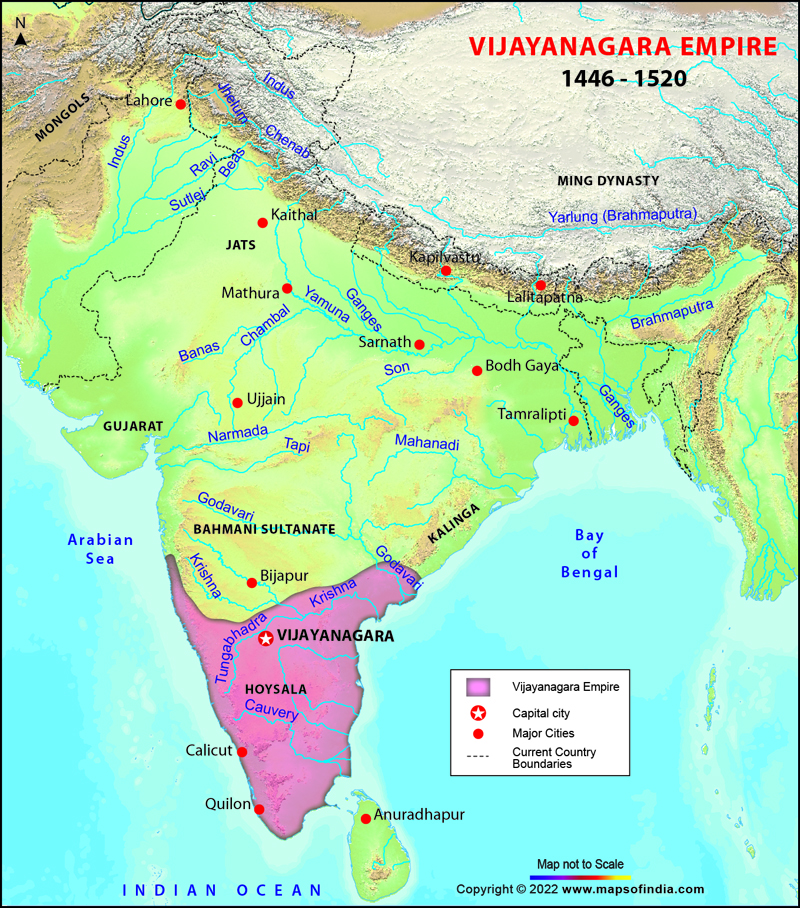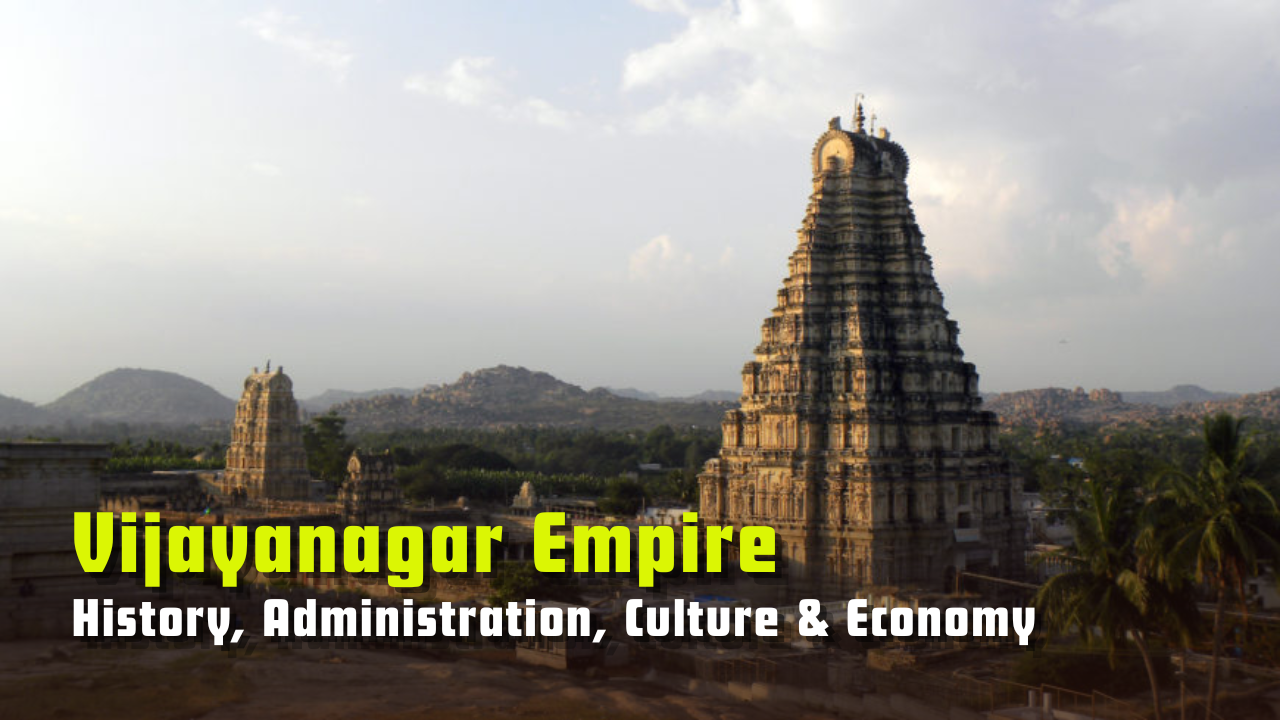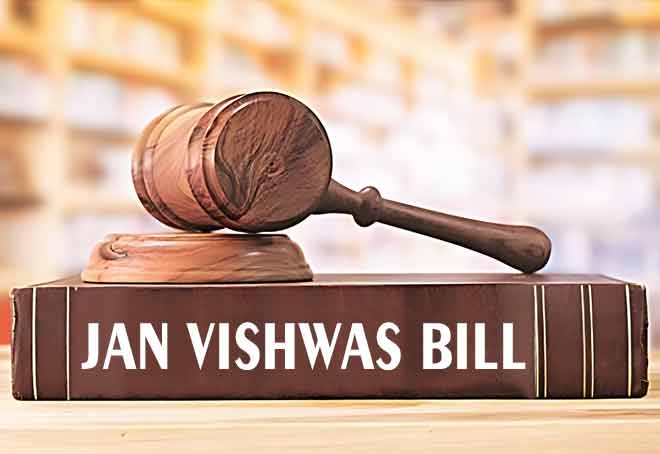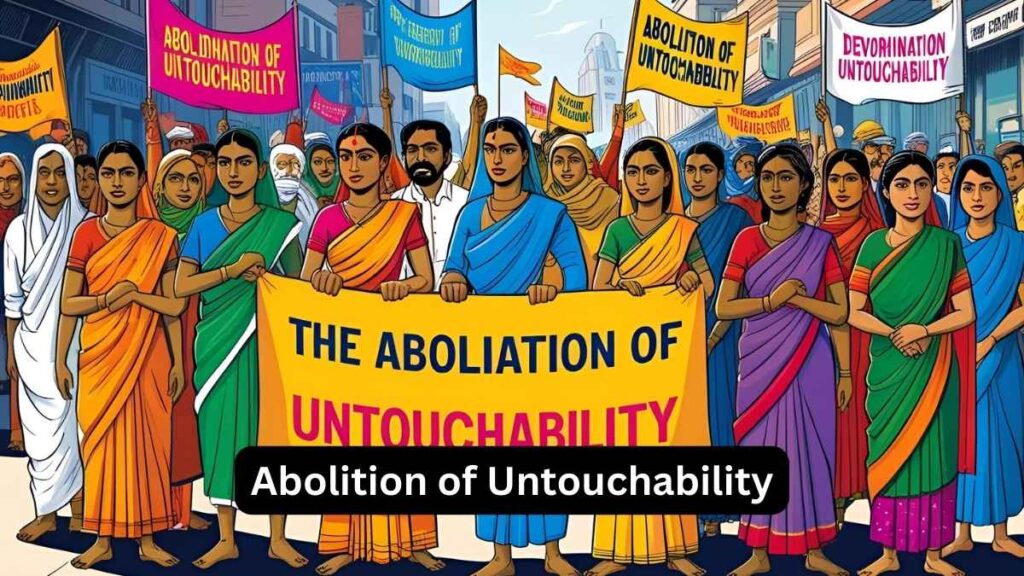Vijayanagar Empire – History, Administration, Culture & Economy
Comprehensive UPSC notes on Vijayanagar Empire: dynasties, rulers, administration, military, culture, and economy. Ideal for Prelims & Mains preparation.
The Vijayanagara Empire (1336 to 1672) is crucial for UPSC preparation, as it has multidimensional history concerns for medieval India. It has relevance in political and administrative history and economic advancement, along with cultural-architectural heritage. Hence, it is helpful for both prelims because of questions based on facts and mains where analysis and descriptions are articulated.
Vijayanagar Empire
The Vijayanagar Empire emerged in 1336 CE and lasted until the late 17th century. It was governed in succession by four principal dynasties: Sangama (1336–1485), Saluva (1485–1503), Tuluva (1503–1570), and Aravidu (1570- ~1672). Its capital, Vijayanagara (modern Hampi, Karnataka), evolved into a prominent cultural, political, and commercial centre.

Sources of Information
- Native texts such as Amukthamalyada (Krishna Deva Raya), Maduravijayam (Gangadevi) and Manucharitam (Allasani Peddanna) offer valuable literary insights.
- Accounts from foreign visitors like Ibn Battuta, Nicolo Conti, Abdur Razzak, and Domingo Paes document social and economic life.
- Inscriptions, including the Srirangam copper plates from Devaraya II’s reign, record royal genealogies.
- Coins issued by Vijayanagar rulers bear legends and depictions that reflect royal authority and achievements.
- The architectural ruins at Hampi serve as a testament to the urban planning and cultural sophistication of the Vijayanagar Empire.
Territorial Reach and Military Conflicts
- In the southern region, the Vijayanagar Empire defeated the Madurai Sultanate around 1377 CE, extending its authority up to Rameshwaram and along the Kerala coastline.
- In the north, it engaged in prolonged warfare with the Bahmani Sultanate, particularly over the Krishna–Tungabhadra region.
- The empire integrated multiple linguistic and cultural groups, including Tamil, Telugu, and Kannada-speaking populations.
Key Rulers and Dynasties
Sangama Dynasty
-
Harihara I and Bukka I (1336–1377)
- The founders of the Vijayanagar Empire initially served the Kakatiya dynasty and later the rulers of Kampili.
- After being captured and converted to Islam by Muhammad bin Tughlaq, they were later reconverted to Hinduism with the guidance of the sage Vidyaranya.
- They established Vijayanagara on the banks of the Tungabhadra River and consolidated power by absorbing the Hoysala territories.
-
Harihara II (1377–1406)
- Expanded the kingdom eastward by defeating the Reddis of Kondavidu.
- Conquered regions including Goa and Belgaum from the Bahmanis.
- Engaged in battles against the Velamas of Telangana and successfully resisted the coalition of the Bahmani Sultanate and Warangal.
-
Deva Raya I (1406–1422)
- Implemented irrigation projects like dams and canals for agricultural growth.
- Strengthened the military by hiring Turkic archers and importing horses from Arabia and Persia.
- Employed a significant number of Muslim soldiers and built amenities for them, including a mosque.
- After suffering initial losses, he defeated Firoz Shah of the Bahmanis, gaining control of key regions.
- Promoted literature and temple architecture; built the Hazara Rama temple.
- Welcomed visitors like Nicolo Conti and Afanasy Nikitin.
-
Deva Raya II (1425–1446)
- Regarded as the most prominent Sangama ruler; also known as Gajabetegara (“Elephant Hunter”).
- Authored literary works in Kannada and Sanskrit.
- Extended patronage to poets like Chamarasa, Kumara Vyasa, and Srinatha, as well as to scholars such as Parameshvara.
- Extended the empire’s reach from Sri Lanka to Orissa and from Malabar to Gulbarga, according to foreign sources.
Saluva Dynasty (1485–1509 CE)
- Founded by Saluva Narasimha, the dynasty was short-lived and primarily transitional.
- It paved the way for the rise of the Tuluvas.
Tuluva Dynasty
-
Krishna Deva Raya (1509–1529)
- Celebrated as the greatest Vijayanagar monarch; earned titles like Abhinava Bhoja and Andhra Bhoja.
- Triumphed over the Bijapur Sultanate in the Battle of Raichur (1520) and re-established the Bahmani Sultanate.
- Campaigned successfully in Orissa, securing territory up to the Krishna River.
- Established diplomatic relations with the Portuguese, who sent envoys such as Albuquerque.
- Patronised the Ashtadiggajas, a group of eight renowned Telugu poets, including Allasani Peddanna, Tenali Ramakrishna, and Pingali Suranna.
- Authored Amukthamalyada (Telugu) and other Sanskrit works (Jambavati Kalyanam, Ushaparinayam).
- Constructed notable temples like Vittalaswamy and Hazara Ramaswamy, and also undertook the renovation of the Tirupati temple.
- Established Nagalapuram, a town named after his mother.
-
Achyuta Deva Raya (1529–1542)
- Brother and chosen successor of Krishna Deva Raya.
- Supported Purandaradasa (founder of Carnatic music), Chatu Vittalanatha, and Rajanatha Dindima II.
- Oversaw the construction of the Achyutaraya temple.
- Portuguese traveller Fernão Nuniz visited his court.
-
Sada Siva Raya (1542–1570)
- A nominal ruler under the real authority of Aliya Rama Raya, Krishna Deva Raya’s son-in-law.
- For his own political advantage, Rama Raya played the Deccan Sultanates against each other through shifting alliances
- His shifting loyalties led to a unified response from the Deccan states (excluding Berar).
- In 1565 CE, the combined forces of Bijapur, Ahmadnagar, Golkonda, and Bidar defeated Vijayanagar at the Battle of Talikota (also called Rakshasa Tangadi).
- Rama Raya was executed, and the city of Vijayanagara was plundered and devastated.
- This defeat marked the beginning of the empire’s decline; traveller Caesar Fredrick later described the ruins.
Aravidu Dynasty (Post-1565 – ~1672 CE)
- After the fall of Vijayanagar, the empire survived under the Aravidu dynasty from new capitals: Penukonda and later Chandragiri.
- Prominent rulers included Tirumala, Sriranga I, and Venkata II.
- The final ruler of Vijayanagar was Sri Ranga III, who reigned till around 1646 CE.
Administration of the Vijayanagar Kingdom
- Central Authority:
- The king (Raya) held supreme authority in executive, judicial, and legislative matters.
- He was the highest court of appeal and had the final say in justice.
- Punishments were often severe, including mutilation and execution by elephants.
- Succession:
- The throne was usually passed on hereditarily, but occasional usurpations occurred (e.g., Saluva Narasimha ending the Sangama dynasty).
- Council of Ministers:
- The king was aided by ministers in administrative affairs.
- Administrative Divisions:
- The empire was divided into Mandalams (provinces), further subdivided into Nadus, Sthalas, and Gramas (villages).
- Mandaleswara, or Nayak, was the governor of a Mandalam.
- Local Governance:
- Local authorities had significant administrative power.
- However, Chola-style village self-governance weakened due to the rise of hereditary nayakships.
- Provincial Governance:
- Initially, royal princes were appointed as governors.
- Later, nobles and vassals were also given governorships.
- Provincial governors had autonomy—they held courts, appointed officials, maintained armies, and occasionally issued coins.
- Their tenure was not fixed and depended on their competence.
- They paid a fixed quota of soldiers and money to the central authority.
- Nature of the Empire:
- Due to the autonomy of provincial governors, the empire functioned more like a confederacy than a centralised state.
- Sources of Revenue:
- Major income came from land revenue, generally fixed at one-sixth of the produce.
- Other sources included tributes from vassals, port customs, and taxes on professions.
| Term | Meaning |
| Padikaval | System of selling rights for maintaining law and order |
| Athavane | Department managing land revenue |
| Raysani | Oral proclamations recorded as royal orders |
| Karnikam | Accountant responsible for financial records |
| Mahanayakachara | Intermediary between rulers and the village administration |
| Talara | Village or city watchman responsible for local security |
| Kadamal / Irai / Vrai | Different types of taxes levied by the state |
| Pradhani | Prime minister |
Vijayanagar Empire: Army and Military Organisation
- Prolonged Conflict with the Bahmani Kingdom
- Frequent wars due to disputes over Raichur Doab (between the Krishna and Tungabhadra rivers) and the Krishna–Godavari delta.
- Required maintenance of a large and efficient army.
- Composition of the Army
- It consisted of infantry, cavalry, artillery, and war elephants.
- Known for being well-organised and disciplined.
- Cavalry and Horse Trade
- High-quality horses were imported from Arabia and the Gulf regions via the Malabar port.
- Malabar was a key hub for horse and luxury goods trade; hence, the empire tried to control it.
- Amara-Nayaka System
- Top army officers were called Nayaks, Palaiyagars, or Poligars.
- They were granted land (amaram) instead of salary.
- Nayaks collected revenue, maintained local military units, and managed agriculture in their territories.
- They were also fort commanders and contributed to temple and irrigation maintenance.
- Nayaks showed loyalty by offering annual tributes and gifts to the king.
- Nayaka Rebellion and Decline
- By the 17th century, powerful nayaks in Tanjore and Madurai declared independence.
- Their rebellion weakened the central authority and played a role in Vijayanagar’s defeat at the Battle of Talikota.
- Use of Firearms and Military Technology
- Vijayanagar rulers adopted firearms like rifles, pistols, and cannons.
- Turkish and Portuguese experts were hired to train the army.
- Forts were built with thick walls, fortified doors, and parapets to mount cannons and withstand artillery attacks.
- The special gun rests and cannon platforms were incorporated in fort design.
Social Life
- The society was divided into four main castes—Brahmins, Kshatriyas, Vaishyas, and Shudras, as mentioned by Allasani Peddanna in Manucharitam.
- Foreign visitors like Paes described the luxurious lifestyle of the rich, with grand homes and numerous servants. Nicolo Conti noted the existence of slavery.
- People wore mainly silk and cotton garments.
- Popular forms of entertainment included dance, music, wrestling, gambling, and cockfighting.
- Religious Beliefs:
- The Sangama dynasty followed Shaivism, worshipping Virupaksha as their family deity.
- Later dynasties leaned towards Vaishnavism, particularly Ramanuja’s Srivaishnavism.
- Religious tolerance was widespread—Barbosa observed that people were free to follow any faith, whether Christian, Jewish, Muslim, or Hindu.
- Muslims held important administrative posts, built mosques, and were part of the military, especially during Deva Raya II’s rule.
- Women’s Position:
- While overall status remained limited, some women were scholars and poets like Gangadevi (Maduravijayam), Hannamma, and Thirumalamma.
- Nuniz reported that many women worked in the royal palace as dancers, servants, and palanquin bearers.
- Sati (sahagaman) and the devadasi system were still prevalent.
- Polygamy was common among royalty.
- Temples played a dual role—religious centres and active participants in trade, both local and international.
Economy
- The empire was highly prosperous, with foreign travellers describing it as one of the richest in the world at the time.
- Agriculture remained the primary occupation. The rulers encouraged it by building tanks, canals, and dams (e.g., across the Tungabhadra River) to improve irrigation.
- Various industries thrived under state patronage, with artisans and metalworkers organised into guilds.
- Diamond mining was prominent in regions like Kurnool and Anantapur.
- Trade was extensive—inland, coastal, and overseas.
- Major seaport: Cannanore.
- Trade relations extended to Arabia, Persia, South Africa, Portugal, Burma, the Malay Peninsula, and China.
- Exports included cotton, silk, spices, rice, sugar, iron, and saltpetre.
- Imports consisted of horses, pearls, copper, coral, mercury, silk, and velvet.
- The art of shipbuilding was well developed.
- The varaha was the main gold coin, but weights and measures varied across regions.
Cultural Contributions of the Vijayanagar Empire

- Temple architecture saw significant advancement during the Vijayanagar period. A distinctive feature was the construction of tall Raya Gopurams (ornate temple gateways) and elaborately designed Kalyanamandapams (marriage halls) with finely carved pillars.
- The pillars often featured intricate sculptures, most notably of horses, and some large mandapams contained hundred- or even thousand-pillared halls used during festivals for placing deities.
- During this era, several existing temples were expanded with the addition of Amman (Goddess) shrines.
- Temples that exemplify the Vijayanagar style include
- Vittalaswamy and Hazara Ramaswamy Temples at Hampi.
- Varadharaja and Ekamparanatha Temples in Kanchipuram.
- The Raya Gopurams at Thiruvannamalai and Chidambaram are notable architectural achievements.
- This architectural legacy was later continued by the Nayak rulers.
- The empire also contributed to metal art, as seen in the bronze statues of Krishna Deva Raya and his queens found at Tirupati.
- Music and dance were actively encouraged and flourished under royal patronage.
- Multiple languages prospered during this period, including Sanskrit, Telugu, Kannada, and Tamil.
- There was remarkable growth in Sanskrit and Telugu literature, particularly under Krishna Deva Raya, who was himself a scholar and literary patron.
- His court poet, Allasani Peddanna, made significant contributions to Telugu literature.
- Overall, the Vijayanagar Empire’s cultural achievements were diverse, influential, and enduring.
Conflict between the Vijayanagar Kingdom and the Bahmani Sultanate
The conflict between the Vijayanagar Empire and the Bahmani Sultanate was a defining feature of medieval Deccan politics. Though often misinterpreted as a religious Hindu–Muslim struggle, these confrontations were rooted in territorial ambition and economic interests, particularly over strategic and resource-rich regions. The clashes occurred primarily in three distinct areas:
Key Areas of Conflict
-
Raichur Doab (Between the Krishna and Tungabhadra Rivers)
-
This area was a fertile and mineral-rich zone, home to the famous Golconda diamond mines.
-
Both kingdoms desired expansion across the Tungabhadra, making this region the primary battlefield.
-
Battles here were frequent but inconclusive, with neither side able to hold control for long.
-
For example, in 1504 CE, the Bahmanis successfully recaptured Raichur Doab. However, Krishna Deva Raya of Vijayanagar later reclaimed Raichur, Mudkal, Nalgonda, and other strategic inland towns.
-
Historically, the Raichur Doab had been contested even earlier by the Chalukyas and Cholas, and later the Yadavas and Hoysalas.
-
-
Krishna–Godavari Basin
-
This agriculturally rich region also offered access to vital sea ports.
-
Ports in this area were crucial for foreign trade, especially for exporting textiles and importing horses, making it an economic priority for both states.
-
-
Marathwada Region and the Konkan Belt
-
The Konkan coast, a narrow strip between the Western Ghats and the Arabian Sea, was extremely fertile.
-
It included Goa, a significant port for importing horses from Iraq and Iran.
-
Control over this area meant strategic access to western maritime trade, further fueling rivalry.
-
Nature and Impact of the Conflict
-
These wars were not religious in origin. The conflicts were primarily about resources, territory, and trade control.
-
The repeated warfare led to heavy destruction, including loss of lives, property, and agricultural productivity in the contested regions.
-
Both powers became so entangled in conflict that they overlooked the growing influence of the Portuguese on the south-western coast, which eventually altered the regional power dynamics.
Diplomatic Engagements and Cultural Exchange
-
Despite ongoing hostilities, the two powers also engaged in periods of cooperation:
-
Krishna Deva Raya supported rival factions within the Bahmani Sultanate and was even known by the title “Establisher of the Yavana Kingdom”.
-
The Sultan of Bijapur once intervened to mediate succession disputes in Vijayanagar after Krishna Deva Raya’s death.
-
-
Cultural interactions flourished in art, literature, and architecture. Architectural techniques, court traditions, and artistic expressions were often influenced by both empires.
Decline and Invasion
Following the death of Deva Raya II in 1446, the Vijayanagara Empire entered a period of long decline, as it was marked by internal strife, weak administration, and bureaucratic collapse. Power struggles over succession and growing ministerial influence undermined central authority, contracting imperial control to the core regions in Karnataka and Andhra. Saluva Narasimha took power, but his dynasty was soon replaced by the Tuluvas. Their most famous ruler, Krishna Deva Raya (1509–1529), restored stability, reclaimed lost territories from Orissa and the Deccan sultanates (Bijapur, Golconda, and Ahmadnagar), and crushed Bijapur at Raichur in 1520. This was fleeting, as later rulers like Sadashiva Raya were titular rulers with actual power residing with minister Rama Raja.
Rama Raya’s cunning diplomacy—playing off Deccan sultanates against one another—sealed the fate at the disastrous Battle of Talikota (1565), also referred to as Rakshasa-Tangadi. An alliance of sultanates (Ahmadnagar, Bijapur, Bidar, and Golconda) defeated Vijayanagar’s army, pillaging the capital and assassinating Rama Raya, the political downfall of the empire. Although the empire survived for another century, it never regained its previous glory, bringing an end to Vijayanagara’s supremacy in South India.
Subscribe to our Youtube Channel for more Valuable Content – TheStudyias
Download the App to Subscribe to our Courses – Thestudyias
The Source’s Authority and Ownership of the Article is Claimed By THE STUDY IAS BY MANIKANT SINGH





